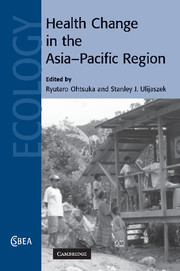Book contents
- Frontmatter
- Contents
- List of contributors
- Acknowledgements
- 1 Health change in the Asia-Pacific region: disparate end-points?
- 2 Interactions of nutrition, genetics and infectious disease in the Pacific: implications for prehistoric migrations
- 3 Biocultural adaptation and population connectedness in the Asia-Pacific region
- 4 Changing nutritional health in South East Asia
- 5 Obesity and nutritional health in Hong Kong Chinese people
- 6 Modernization, nutritional adaptability and health in Papua New Guinea Highlanders and Solomon Islanders
- 7 Tongan obesity: causes and consequences
- 8 Nutrition and health in modernizing Samoans: temporal trends and adaptive perspectives
- 9 Health patterns of Pacific Islanders and Asians in the United States
- 10 Impacts of modernization and transnationalism on nutritional health of Cook Islanders
- 11 Mortality decline in the Pacific: economic development and other explanations
- 12 Health changes in Papua New Guinea: from adaptation to double jeopardy?
- Index
- References
2 - Interactions of nutrition, genetics and infectious disease in the Pacific: implications for prehistoric migrations
Published online by Cambridge University Press: 15 September 2009
- Frontmatter
- Contents
- List of contributors
- Acknowledgements
- 1 Health change in the Asia-Pacific region: disparate end-points?
- 2 Interactions of nutrition, genetics and infectious disease in the Pacific: implications for prehistoric migrations
- 3 Biocultural adaptation and population connectedness in the Asia-Pacific region
- 4 Changing nutritional health in South East Asia
- 5 Obesity and nutritional health in Hong Kong Chinese people
- 6 Modernization, nutritional adaptability and health in Papua New Guinea Highlanders and Solomon Islanders
- 7 Tongan obesity: causes and consequences
- 8 Nutrition and health in modernizing Samoans: temporal trends and adaptive perspectives
- 9 Health patterns of Pacific Islanders and Asians in the United States
- 10 Impacts of modernization and transnationalism on nutritional health of Cook Islanders
- 11 Mortality decline in the Pacific: economic development and other explanations
- 12 Health changes in Papua New Guinea: from adaptation to double jeopardy?
- Index
- References
Summary
Introduction
Like some huge natural experiment in population genetics and evolution, South East Asia and the Pacific region combine elements of ancient and recent colonizations, of admixture and of entry into chains of uninhabited islands with extreme founder effects alongside the powerful and interacting evolutionary selective effects of nutrition and infectious disease. New Guinea was one of the first places in the world to achieve its own Neolithic revolution. This may have signalled the onset of specific micronutrient deficiencies, in particular of iron. Neolithic sedentary behaviour may have also increased transmission of malaria. Malaria is a major lethal disease in South East Asia and lowland Near Oceania although not in Far Oceania and, since the Late Pleistocene, has exerted strong selective effects promoting genetic disorders of globin-chain and red cell production. Overlaying this selective mechanism is an exquisite three-way interaction between micronutrient availability (in particular iron), infectious disease (in particular malarial susceptibility) and genetic protection (in particular alpha-globin gene deletions). The Holocene change from mobile hunting and gathering to arboriculture, horticulture and sedentary living may have acted to increase the level of iron deficiency in early childhood both as a result of nutritional inadequacy and as a secondary result of malaria and genetic causes of anaemia in the iron stores of newborn infants. Over-enthusiastic attempts to correct such deficiency have the unfortunate effect of increasing both malarial and non-malarial infectious morbidity.
- Type
- Chapter
- Information
- Health Change in the Asia-Pacific Region , pp. 21 - 43Publisher: Cambridge University PressPrint publication year: 2007



